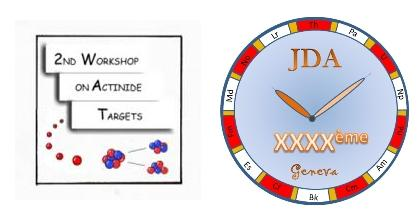Speaker
Dr
Shadi Yasin
(Hochfeld-Magnetlabor Dresden, Forschungszentrum Dresden-Rossendorf, Germany)
Description
The Uranium ternary intermetallic material UIrGe belongs to the large family of UTX compounds (T = transition metal and X = Si or Ge) and crystallizes in the orthorhombic TiNiSi-type structure (space group Pnma) [1]. Its isoelectronic analogs URhGe and UCoGe have recently attracted much attention due to exotic coexistence of ferromagnetism and super-conductivity [2,3]. Previous high-field magnetization, specific-heat, and neutron-diffraction studies on a single crystal of UIrGe reveal antiferromagnetic (AF) ordering below TN = 16 K [4-7]. The AF structure of the U magnetic moments in UIrGe is non-collinear and commensu-rate with the crystallographic unit cell. The four ordered U moments in the unit cell are strongly reduced (0.36 B/U at 1.8 K) compared to the U3+ or U4+ single-ion moment. UIrGe exhibits a large magnetic anisotropy with the hard magnetization direction along the a axis. For magnetic fields applied along the b and the c axis, a metamagnetic transition (MT) to-wards a field-induced ferromagnetic (FIF) phase is observed. At 2 K, the critical fields Bc of the MTs along the b and the c axis are 21 and 14 T, respectively.
In the present work, we report results on the sound velocity v and sound attenuation as a function of temperature and magnetic field in UIrGe. The UIrGe single crystal (grown in a tri-arc furnace by use of the Czochralski method) studied in the present experiment is the same crystal used previously for magnetic measurements [5,6]. The ultrasound measurements were performed using the pulse-echo technique [8] at a frequency of 62 MHz. A pair of piezoelec-tric film transducers were glued to prepolished flat and parallel faces normal to the b axis. The absolute value of the sound velocity in zero magnetic field was extracted from the “echo train” of the ultrasonic signal and is found to be equal to 4250 m/s at 4.2 K. The temperature and magnetic field dependences of the acoustic characteristics were measured in static field (up to 18 T) applied along the c axis. Since the transition field along the b axis exceeds the available steady-field value, the field dependence in this direction was measured in pulsed fields up to 32 T at 4.2 K.
The field- and temperature-dependent changes of the acoustic properties normalized to the values at 4.2 K and zero magnetic field are presented in Figs. 1-4. Figure 1 shows the tem-perature dependence of the longitudinal sound velocity along the b axis vbb in zero field and 12 T applied along the c axis (both the wave vector k and the sound-polarization vector u are parallel to the b axis). The sound velocity in zero field displays a step-like anomaly of the or-der of 110-4 at TN = 16 K. At 12 T, an anomaly, that is by more than one order larger, appears at lower temperatures (10.4 K). This is caused by the transition to the FIF state above the metamagnetic transition. As seen in Fig. 2, the metamagnetic transition for fields applied along the c-axis is accompanied by a lattice softening with a sound-velocity change of about 1.510-3. A similar effect is observed at the metamagnetic transition for fields applied along the b axis as well (Fig. 3). Thus, the metamagnetic transitions affect the sound velocity much stronger than the spontaneous antiferromagnetic ordering. Regarding the sound attenuation, the metamagnetic transition manifests itself by a strong additional dissipation (Fig. 4; a simi-lar effect is observed for fields applied along the c axis).
We will discuss the observed magnetoelastic effects in conjunction with magnetization and specific-heat results reported earlier [5,6].
Primary author
Dr
Shadi Yasin
(Hochfeld-Magnetlabor Dresden, Forschungszentrum Dresden-Rossendorf, Germany)
Co-authors
Prof.
Alexander V. Andreev
(Institute of Physics ASCR, Na Slovance 2, 182 21 Prague 8, The Czech Republic)
Prof.
Joachim Wosnitza
(Hochfeld-Magnetlabor Dresden, Forschungszentrum Dresden-Rossendorf, Germany)
Dr
Sergei Zherlitsyn
(Hochfeld-Magnetlabor Dresden, Forschungszentrum Dresden-Rossendorf, Germany)




